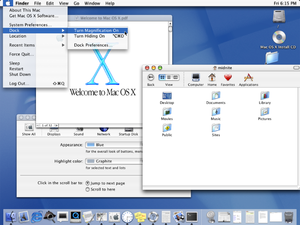Mac OS X 10.0
| A version of the macOS operating system | |
 |
|
 |
|
| Developer | Apple Computer |
|---|---|
| OS family | |
| Source model | Closed source (with open source components) |
| Released to manufacturing |
March 24, 2001 |
| Latest release | 10.0.4 / June 22, 2001 |
| Platforms | PowerPC |
| Kernel type | Hybrid (XNU) |
| License | Apple Public Source License (APSL) and Apple end-user license agreement (EULA) |
| Preceded by | Mac OS 9 |
| Succeeded by | Mac OS X 10.1 Puma |
| Official website | Apple - Mac OS X at the Wayback Machine (archived June 29, 2001) |
| Support status | |
| Unsupported | |
Mac OS X version 10.0, code named Cheetah, is the first major release of Mac OS X (now named macOS), Apple’s desktop and server operating system. Mac OS X 10.0 was released on March 24, 2001 for a price of US$129. It was the successor of the Mac OS X Public Beta and the predecessor of Mac OS X 10.1.
Mac OS X 10.0 was a radical departure from the classic Mac OS and was Apple’s long-awaited answer for a next generation Macintosh operating system. It introduced a brand new code base completely separate from Mac OS 9's, as well as all previous Apple operating systems. Mac OS X introduced the new Darwin Unix-like core and a completely new system of memory management. Cheetah proved to be a rocky start to the Mac OS X line, plagued with missing features and performance issues, although it was praised for being a good start to an operating system still in its infancy, in terms of completeness and overall operating system stability. Unlike releases of Mac OS X 10.2 to 10.8, the cat-themed code name was not used in marketing the new operating system.
The system requirements for Mac OS X 10.0 were not well received by the Macintosh community, as at the time the amount of RAM standard with Macintosh computers was 64 megabytes (MB), while the Mac OS X 10.0 requirements called for 128 MB of RAM. In addition, processor upgrade cards, which were quite popular for obsolete pre-G3 Power Macintosh computers, were not supported (and never officially have been, but can be made to work through third-party utility programs). Additionally the new operating system required more hard drive space, causing longer boot times.
...
Wikipedia
